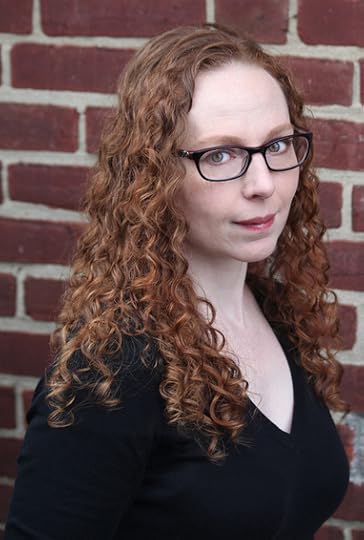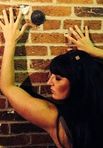Carpe Noctem Interview With Dawn Manning
 Burlesque Press, 2016 THINGS WE’RE DYING TO KNOW…
Burlesque Press, 2016 THINGS WE’RE DYING TO KNOW…Let’s start with the book’s title and your cover image. How did you choose each?
The title Postcards from the Dead Letter Office came to me as I was writing dozens of short, image-centric poems, mostly place-based, that were just the right size to fit on a postcard. I’ve always been fascinated with dead letter offices—all those letters that never made it to their destination secreted away in dark back rooms. That image surfaced in my mind, so I made it the name of the file I stashed these poems in and it stuck.
The cover image was commissioned by my publishers at Burlesque Press and was designed by Malaysia-based artist Andrea Tan. I love the handwritten font and the dreamy pastels. I also love that the blurbs on the back were on postcards.
Can you describe your writing practice or process for this collection? Do you have a favorite revision strategy?
This collection grew out of my search for resonate imagery. I was focused on honing what for me were the deep images of the places I’ve been and trying to make them fresh. I was asking myself how I could take stereotypical images like a Incan ruins in Peru or the high rises of Hong Kong and make them new (I’m frequently haunted by Ezra Pound). And then I discovered the Japanese practice of tanka poetry and that became the scaffolding for this collection.
For revision I focused on clarifying these images and making them as concise as I could. At first I wasn’t sure how I could cut so much from poems that, at most, were often only 31 syllables long, but I was amazed at how often there were whole phrases—though lovely in themselves—that weren’t really contributing to the central image. So I whittled them down one word at a time until I was left with these distilled images and responses to images.
How did you order the poems in the collection? Do you have a specific method for arranging your poems or is it sort of haphazard, like you lay the pages out on the floor and see what order you pick them back up in?
I arranged the tanka in sets based on season and place. The sets I arranged from spring to winter, and the places are roughly in the order of the season they correspond with. I print up everything and physically move the poems around on the floor. It’s like trying to play the world’s most enigmatic game of Tetris.
What do you love to find in a poem you read, or love to craft into a poem you’re writing?
I thrill at metaphors that startle me with their originality and yet are so precise that I’m left wondering how I never saw the connection before. I also adore well-used internal rhyme, assonance, consonance, and slant rhyme.
Can you share an excerpt from your book? And tell us why you chose this poem for us to read.
we feel our way through
cathedral ribs arched along
canals like beached whales,
each one of us a Jonah
seeking out a second chance
I find it’s often hard to be an accurate judge of my own work. I chose this poem from the set of tanka set in Venice because it has resonated with a lot of people. I wrote it near the end of compiling the manuscript and I felt very vulnerable when I wrote it—as if I’d written piles of poem just to get to this place where I could say I’m still seeking in just this way.
If you had to convince someone walking by you in the park to read your book right then and there, what would you say?
Most of these poems are only five lines long.
I’ve heard poets say that they’re writing the same story over and over in their poems. Is that true for you?
I’ve definitely caught myself gravitating to certain themes or topics. Some of my pets include death, socio-political issues of women and children, anthropology, travel, liminal spaces, myth, the role of belief in our lives (religious or otherwise), and the sacred-profane.
Are there other types of writing (dictionaries, romance novels, comics, science textbooks, etc.) that help you to write poetry?
I read a little of everything, but I go on long, winding word bunny trails through the
dictionary or thesaurus when I’m trying to pick my way through a knot in a poem I’m working on.
What are you working on now?
Fixing my leaky basement. After that, I’ll work on writing some longer poems. Probably about a leaky basement.
What book are you reading that we should also be reading?
Vampires, Burial, and Death: Folklore and Reality by Paul Barber
Without stopping to think, write a list of five poets whose work you would tattoo on your body, or at least write in permanent marker on your clothing, to take with you at all times.
Mizuta Masahide, Lisel Mueller, Lucille Clifton, Carolyn Forche, Sylvia Plath, and because poets never obey the rules, here’s the misquote of a fiction writer I’d ink: “Strangle your darlings” (Faulkner).
***
Purchase Postcards from the Dead Letter Office.
 Dawn Manning is the author of Postcards from the Dead Letter Office, which The Philadelphia Inquirer describes as "exquisite… crystalline... Manning weaves an intricate tapestry out of the bits and pieces of human performance and the tension that so often marks it, putting precise images and phrases into concise but intricate counterpoint." Her awards for poetry include the Beullah Rose Poetry Prize, the Edith Garlow Poetry Prize, and the San Miguel Writing Award, among others. Her poems have been published through Crab Orchard Review, Silk Road Review, Smartish Pace, and other literary journals. When the stars align, she travels. Visit her online at Dawnmanning.com.
Dawn Manning is the author of Postcards from the Dead Letter Office, which The Philadelphia Inquirer describes as "exquisite… crystalline... Manning weaves an intricate tapestry out of the bits and pieces of human performance and the tension that so often marks it, putting precise images and phrases into concise but intricate counterpoint." Her awards for poetry include the Beullah Rose Poetry Prize, the Edith Garlow Poetry Prize, and the San Miguel Writing Award, among others. Her poems have been published through Crab Orchard Review, Silk Road Review, Smartish Pace, and other literary journals. When the stars align, she travels. Visit her online at Dawnmanning.com.
Published on September 08, 2016 04:19
No comments have been added yet.



